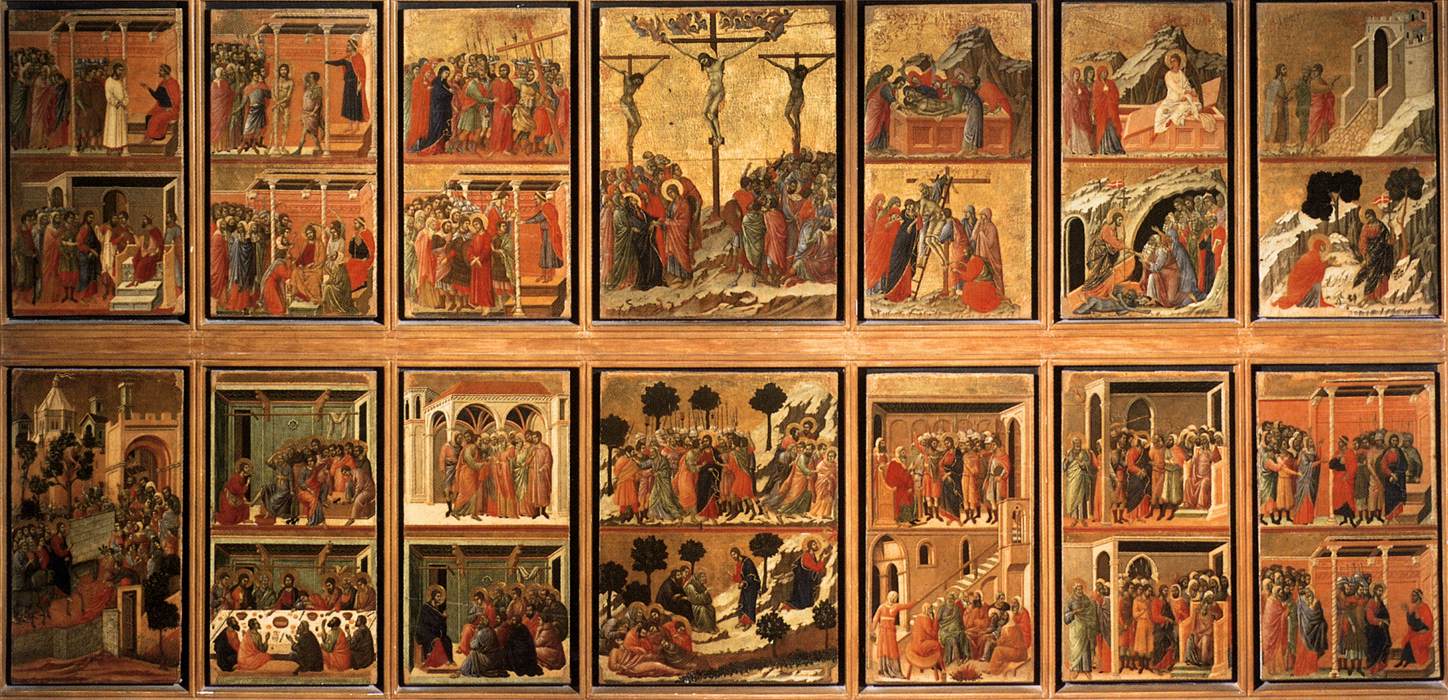Duccio’s Passion of Christ- a painter’s pespective
More Traveller’s Tales:-I revisited an old friend in Siena this summer, one I had met many times before but this time we managed a quiet hour together instead of a rushed conversation in a crowd. The friend in question is Duccio’s Maesta, specifically the Passion of Christ on the back of the Altarpiece. It was painted to be seen up close by the clergy and others with privileged access behind the altar in the Siena Duomo and tells the story of Christ’s last week on earth. This reproduction does no justice at all to the real thing which measures a magnificent fifteen foot across and a similar height when fully reassembled.
It reads like a book for an audience that read in images rather than words, but unlike a book starts from the bottom and works up towards heaven. It was made almost exactly 700 years ago and to my mind has never been equaled since in the subtlety, sophistication and perfection achieved in the synthesis of abstract design and narrative that Duccio masterminded. Although each of the 26 panels can be read as a beautiful unique painting it is in the connections, repetitions, echoes, and rhythms between the panels that the work as a whole is so utterly compelling.
The ancient comic strip opens bottom left with a double image Entry into Jerusalem, a capital letter to start things off as would happen in a medieval manuscript. It reads towards the top right where Christ is on another road just before entering Emmaus where he leaves this world for the final time. Throughout the panels a strong diagonal movement from bottom left to top right takes place in terms of the architectural and landscape structures and consistent lighting sources through the panels, all of which lead one’s eye to Christ’s departure from this world in the final panel.
The dominant colours throughout the panels are gold and red in all its guises: scarlet, vermillion, cadmium, burnt sienna, hot pink, the colour of the Passion and of Christ’s blood.
The use of background colour as a secondary theme establishes chapters in the story. They move from cool greens in the first quadrant where Christ is surrounded by his disciples, moving to pale cream fading to umber backgrounds for the betrayal and denials, building up through a frenzy of crowds where the background colours get hotter and more agitated, culminating in the large Crucifixion scene where the unruly aggressive gang of soldiers to the right of Christ seem to be drowning in a river of scarlet blood flowing from the crucifix above. After the Crucifixion the crowds melt away, the scenes empty out and fade to gold for final days between the Resurrection and the Ascension into Heaven.
Duccio allows one to follow each character through the entire altarpiece by following colour even if one is too far away to read faces. Wonderful touches include Christ’s and Mary’s colours of blue and red being a mirror image of Pontius Pilate, the clash of reds that takes place between Christ’s and Judas’ cloaks in the betrayal, and Christ’s cloak taking on a golden shimmer after he is risen from his tomb.
Then there are the echoes that occur throughout the panels. Examples include those between the three crosses in the Crucifixion with the tree groupings below and the columns of the Pontius Pilate scenes, the subtle leading of the eye along the panels as one is led from for example the Betrayal by the disciples hurrying out to the right of the panel into the next one through the archway into Christ appearing before Annas, or the maidservant’s arm pointing to Peter by the fire but also to him in all three Denials, or the arches on the left of the Denials being repeated above in the Harrowing.
I could go on endlessly but I’m sure you get the drift of the complexity and marvelous subtleties of the Passion as a whole. I would just love to see the whole altarpiece reunited, reassembled and back on the high altar in the Duomo. Sadly that will never happen as key panels have been lost and a few others have traveled far from Siena. The Passion, the Maesta and the other panels still in Siena are now in the Duomo Museum. What one can ascertain however is that the wonderful colour accents and themes continue throughout the Altarpiece. The dominant reds of the Passion fade into creams and golds as one’s eye travels up and down the back of the Altarpiece from the Last Days of the Virgin to the scenes from the Life of Christ, but I do wonder what colour dominated the now lost Ascension into Heaven at the pinnacle of the Altarpiece.

